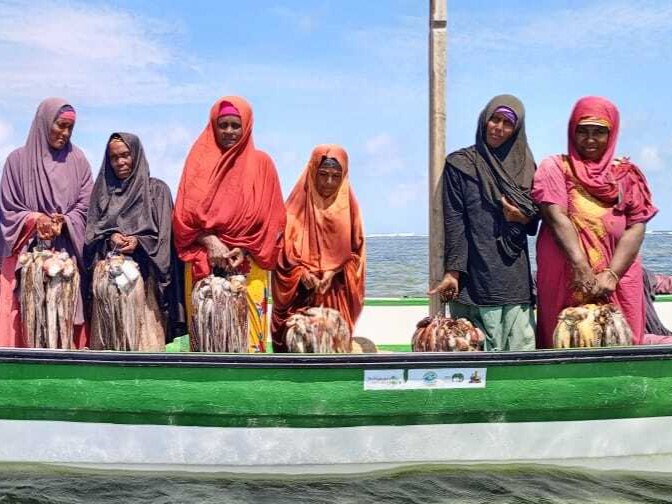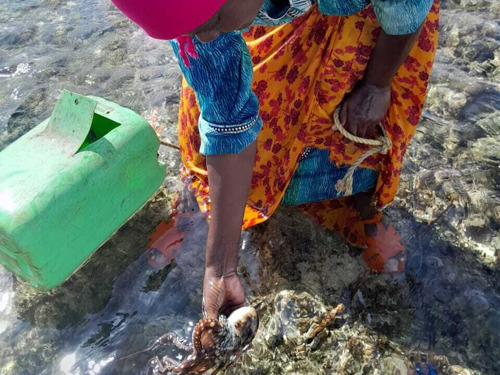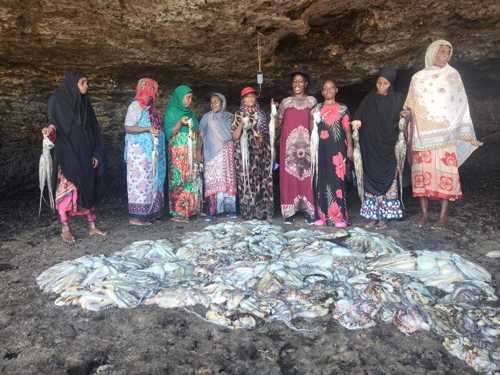Women-led marine management

Octopus fishers proudly display their harvest. Credit - NRT Coast.
Lessons from the field: Locally Managed Marine Areas in Kiunga and Pate
Introduction
The establishment and effectiveness of Locally Managed Marine Areas (LMMAs) are crucial for sustainable fisheries management and marine biodiversity conservation in Kenya’s coastal regions. This project has supported strengthening the functionality of both existing and newly established LMMAs through collaborative efforts involving Beach Management Units (BMUs), conservancy rangers, and government agencies such as the Kenya Fisheries Service, County Fisheries Department, and Kenya Wildlife Service. The key stakeholders have worked together to enhance awareness, monitor compliance, and mitigate illegal fishing activities within the LMMAs.
Key activities and achievements
A major achievement through project intervention was the facilitation of LMMA awareness and progress review meetings both in Kiunga and Pate conservancies to assess the progress of LMMAs and outline strategies for improvement. These discussions led to the drafting of by-laws for LMMAs and octopus closures under Kiunga and Ishakani BMUs, the establishment of LMMA management committees under the Pate Marine Conservation Committee, and the development of an action plan to address key priority areas for LMMA enhancement.
 Women fishers displaying their octopus catch at Mwamba Mkuu LMMA. Credit - NRT Coast.
Women fishers displaying their octopus catch at Mwamba Mkuu LMMA. Credit - NRT Coast.
A remarkable accomplishment in sustainable fisheries management was the effective execution of five octopus closures in Kiunga and three octopus closures in Pate, conducted between March 2023 and January 2025. These closures resulted in a total catch of 5,961 kg of octopus, generating 671,575 Kenyan Shilling (approximately £4,300) in revenue. The fisher communities have reaped substantial benefits, securing double the standard local market price, thereby enhancing their livelihoods and strengthening their dedication to conservation efforts.
Over the course of the project, women have increasingly been involved in decision-making and management of octopus closures. “When we started the octopus farm, the community understood its importance, benefits, and the principles of good conservation leadership. The coral reefs have remained intact, and small fish have grown bigger. The profits we earn from selling octopus have been saved and used to sustain our livelihoods. Women have gained leadership roles in marine management, and people have become more aware of the importance of protecting marine resources,” said Amina Ahmed, the Pate Marine Community Conservancy Board member.

Challenges and considerations
Despite achievements to date, several obstacles still require attention. Governance and enforcement gaps require strengthening to ensure adherence to LMMA regulations. Continuous stakeholder coordination among BMUs, conservancies, and government agencies is necessary to optimise conservation impact. Market access and pricing structures remain pivotal in influencing fisher adoption of sustainable practices.
Conclusion
The ongoing consultations and adaptive management strategies in Lamu, Kiunga, and Pate conservancies underscore the potential of community-driven marine conservation initiatives. Field experiences highlight the importance of collaboration, regulatory frameworks, and sustainable fisheries practices in ensuring the long-term sustainability of marine resources. Moving forward, addressing governance challenges, enhancing enforcement mechanisms, and exploring innovative LMMA models such as seagrass conservation will be essential in achieving both conservation and livelihood objectives. This includes an increased focus on gender equity, particularly in relation to leadership and decision-making. In this regard, the project and participants are benefiting from a sister project, led by Fauna & Flora that is promoting gender equitable norms to improve BMU and conservancy governance.
With continued stakeholder engagement and support, these LMMAs can serve as exemplary models for marine conservation and sustainable fisheries management across Kenya’s coastal regions.

Written by Jeniffer Adero and Emmanuel Gafo. For more information on this Darwin Initiative Main project 29-008, led by Fauna & Flora, please click here.

 Back
Back